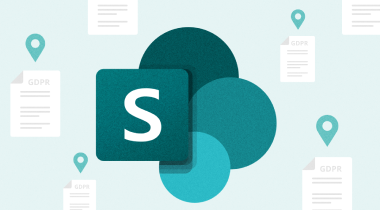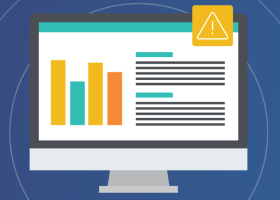What Is Sensitive Information
You’ve secured your networks, trained your employees, and installed the latest security tools. But here’s the reality: most breaches don’t happen because systems fail. They happen when sensitive information slips through everyday channels or gets mishandled by someone in your organization with good intentions.
That’s where true sensitive information protection starts. Not with checklists, but with awareness.
Today’s breaches bring more than just technical headaches; they lead to significant fines, legal repercussions, and long-term damage to a brand's reputation. And with regulations only getting stricter, the cost of getting it wrong continues to rise.
Sensitive information protection isn’t about ticking compliance boxes anymore. It’s about knowing where your data resides, implementing smart controls, and fostering a security culture that scales with your business.
Let’s jump in and learn:
- Understanding the Basics of Sensitive Information
- Understanding Personal Information That Identifies Your People
- The Hidden Value of Business Information
- Building an Enterprise-Grade Data Classification Structure
- Implementing Rapid Protection Strategies
- Best Practices for Sustainable Protection
- Conclusion
- Frequently Asked Questions
Understanding the Basics of Sensitive Information
Sensitive information refers to any type of data that could cause harm to individuals, organizations, or business operations if improperly handled or disclosed. This definition extends well beyond obvious examples, such as credit cards or Social Security numbers.
Your organization likely handles numerous types of data that require varying levels of protection based on their potential impact.
The key to effective sensitive information protection lies in understanding context. Information sensitivity often depends on factors like industry regulations, contractual obligations, competitive implications, and potential harm to individuals or the organization.
When evaluating whether information qualifies as sensitive, consider these critical factors:
- Impact assessment: What consequences would follow if this information became public or fell into the wrong hands?
- Regulatory requirements: Do industry regulations or legal frameworks mandate specific protections for this type of information?
- Contractual obligations: Have you committed to protecting this information through customer agreements, vendor contracts, or partnership arrangements?
- Competitive considerations: Would disclosure of this information benefit competitors or harm your market position?
Building effective protection strategies requires understanding these nuances rather than applying comprehensive security measures. The goal is to create proportional responses that match the actual risk level of different types of information.
Understanding Personal Information That Identifies Your People
Personal information represents one of the most regulated categories of sensitive data. Traditional Personally Identifiable Information (PII) includes obvious identifiers, but the scope has expanded dramatically with digital transformation and evolving privacy regulations.
Classic sensitive information examples include well-known data elements like Social Security numbers, financial account details, physical addresses, medical records, and educational history. However, modern personal information extends far beyond these traditional examples.
Digital interactions create new categories of identifying information that require protection. Digital identifiers such as IP addresses, device fingerprints, and login credentials can link activities to specific individuals. Behavioral data, including browsing patterns, location history, and usage analytics, can create detailed profiles of individual preferences. Biometric information, such as fingerprints and facial recognition data, represents permanent characteristics that cannot be altered if compromised.
Sensitive information examples in the personal category now encompass financial records, health information, biometric data, racial or ethnic background, religious beliefs, and political affiliations. Organizations collecting such information must provide clear disclosure about its use and obtain appropriate consent before processing.
The Hidden Value of Business Information
Business information represents the intellectual capital and operational knowledge that differentiates your organization in the marketplace. This category often receives insufficient attention because its value may not be immediately apparent to all stakeholders.
Critical business information requiring protection includes strategic intelligence such as merger and acquisition plans, market expansion strategies, and competitive analysis. Financial data, including revenue forecasts, pricing models, and cost structures, provides competitors with valuable insights. Intellectual property, such as trade secrets, proprietary algorithms, and research data, represents core competitive advantages that require the highest level of protection.
Distinguishing Between Confidential and Sensitive Information
Many professionals use the terms "confidential" and "sensitive" interchangeably, but understanding their distinct meanings is crucial for implementing appropriate protection measures and access controls.
- Sensitive information encompasses a broader category that includes any data requiring protection for legal, regulatory, contractual, or business reasons. Not all sensitive information carries the same risk level if disclosed, allowing for varied protection approaches.
- Confidential information represents a subset of sensitive information that must remain private and restricted to specifically authorized individuals. Unauthorized disclosure of confidential information typically causes significant harm to individuals, organizations, or business operations.
Understanding confidential vs sensitive information influences access control design, storage requirements, handling procedures, and incident response protocols. Confidential information requires stricter authorization mechanisms, enhanced encryption standards, special transmission methods, and more severe response protocols compared to general sensitive information.
Building an Enterprise-Grade Data Classification Structure
Effective sensitive information protection requires a structured approach to categorizing information based on its sensitivity level and potential impact if disclosed. Most successful organizations implement a four-tier classification system that strikes a balance between security requirements and operational efficiency.
Public Information
Public information includes data that can be shared openly without risk to the organization or individuals. This includes marketing materials, press releases, published research, and general company information intended for public consumption. While requiring no protection controls, organizations should maintain version control, ensure brand consistency, and conduct regular reviews to prevent accidental inclusion of sensitive details.
Internal Information
Internal information is intended for use within the organization but poses minimal risk if disclosed externally. This includes routine business communications, internal policies, organizational charts, and standard operating documents. Internal information requires basic access controls, standard backup procedures, and regular updates to remove outdated materials.
Confidential Information
Confidential information requires careful access control and could cause significant harm if inappropriately disclosed. This category includes sensitive business strategies, detailed financial information, customer data, and proprietary processes. Protection requires role-based access controls, encryption for storage and transmission, comprehensive audit logging, and formal approval processes for external sharing.
Restricted Information
Restricted information represents the highest-risk category, where unauthorized disclosure could result in severe consequences, including legal liability, major financial losses, or business failure. This requires multi-factor authentication, end-to-end encryption with robust key management, continuous monitoring with real-time alerting, and strict 'need-to-know' access principles.
Implementing Rapid Protection Strategies
Protecting sensitive information requires combining technical security measures with administrative controls and user awareness programs. Effective protection strategies address both external threats and internal risks while maintaining operational efficiency.
Technical Controls: Your Security Foundation
Technical controls form the backbone of any sensitive information protection strategy. These controls should work together to create a layered defense mechanism that protects data throughout its lifecycle.
- Encryption Implementation: Deploy strong encryption for data at rest, in transit, and during processing. Use industry-standard encryption algorithms and maintain secure key management practices that provide strong protection while remaining transparent to users.
- Access Management Systems: Implement identity and access management solutions with role-based controls that align with your data classification framework. Regular access reviews ensure that permissions remain appropriate as roles within the organization change.
- Network Security Architecture: Use network segmentation to isolate sensitive systems from general networks. Implement firewalls, intrusion detection systems, and monitoring tools that provide comprehensive visibility into data flows and potential security threats.
- Continuous Monitoring: Deploy monitoring solutions that provide real-time alerting for suspicious activities while maintaining detailed audit logs. Monitoring should encompass user activities, system changes, and data access patterns to identify potential security incidents quickly.
- Data Loss Prevention: Implement DLP solutions that prevent unauthorized data transmission while allowing legitimate business activities. DLP systems should integrate with your classification framework to apply appropriate controls based on the sensitivity levels of the data.
- Backup and Recovery: Maintain secure, sensitive information backups with tested recovery procedures. Backup systems should incorporate the same security controls as those applied to production systems, with additional protections in place for long-term retention.
Governance and Process Management Through Administrative Controls
Administrative controls establish the policies, procedures, and governance structures that guide organizational handling of sensitive information. These controls provide the framework within which technical measures operate.
- Data Governance Policies: Develop comprehensive policies addressing data handling, retention, and disposal requirements. Policies should be clear, actionable, and regularly updated to reflect changing business needs and regulatory requirements.
- Access Management Procedures: Establish formal processes for granting, reviewing, and revoking access to sensitive information. These procedures should include approval workflows, periodic access reviews, and automated processes for managing access changes.
- Security Awareness Training: Implement regular education programs that keep security considerations at the forefront of all employees' minds. Training should be tailored to specific roles, addressing current threat landscapes and organizational policies.
- Incident Response Planning: Develop documented procedures for handling security incidents. Response plans should include clear escalation procedures, communication protocols, and recovery strategies that minimize the impact while ensuring timely and appropriate stakeholder notification.
- Vendor Management: Establish requirements and oversight procedures for third parties handling sensitive information. This includes contractual obligations, security assessments, and ongoing monitoring of vendor compliance.
- Regular Auditing: Conduct periodic reviews to ensure that controls remain effective and appropriate. Audits should assess both technical implementations and administrative procedures, identifying opportunities for improvement.
Best Practices for Sustainable Protection
Sustainable sensitive information protection requires ongoing commitment to security practices that evolve with changing business needs and threat landscapes. Effective protection strategies strike a balance between security requirements and operational efficiency, while maintaining long-term viability.
Continuous Discovery and Classification
Implement automated tools that continuously scan systems to identify and classify sensitive information as it appears. Manual classification processes cannot keep pace with the rapid growth of modern data creation, making automation essential for comprehensive coverage.
Regular Risk Assessment
Conduct periodic assessments that identify new threats, evaluate control effectiveness, and prioritize security investments based on actual risk levels. Risk assessments should consider both external threats and internal vulnerabilities while addressing changing business conditions.
Employee Education and Awareness
Develop comprehensive training programs that enable employees to understand their responsibilities and make informed, security-conscious decisions. Training should be role-specific, regularly updated, and reinforced through ongoing communications.
Security Culture Development
Assist organizational cultures that prioritize security considerations in daily activities. This includes leadership commitment, clear expectations, and recognition programs that reward security-conscious behavior.
Technology Integration
Implement security technologies that integrate seamlessly with existing business processes. Security solutions should enhance productivity while providing comprehensive protection, rather than hindering it.
Incident Preparedness
Maintain robust incident response capabilities that can swiftly address security breaches while minimizing the impact on business operations. This includes regular testing, staff training, and coordination with external partners.
Conclusion
Protecting sensitive information requires more than implementing basic security measures or checking compliance boxes. It requires a comprehensive understanding of your data landscape, the thoughtful implementation of appropriate controls, and an ongoing commitment to security practices that evolve with your business.
Effective sensitive information protection starts with accurately identifying sensitive information examples within your specific environment and implementing proportional safeguards that address actual risks. This includes understanding the distinction between confidential vs sensitive information and applying appropriate controls based on these classifications.
Platforms like Egnyte can support these efforts by providing integrated solutions for data classification, access control, data governance solutions, and compliance management. These tools help organizations implement comprehensive protection strategies while maintaining the operational efficiency necessary for business success.
Frequently Asked Questions
Q. What exactly counts as sensitive information in my business?
Any data that could harm your business, customers, or employees if disclosed. This includes customer records, financial data, employee information, business strategies, and intellectual property.
Q. How do I know if information should be classified as confidential or just sensitive?
Confidential information causes significant harm if disclosed and needs strict access controls. Sensitive information requires protection, but may have broader access. Ask: "What's the worst-case impact?"
Q. Do I need expensive tools to protect sensitive information effectively?
Start with basic controls like access restrictions, encryption, and employee training. You can add advanced tools as your program matures and budget allows.
Q. How often should I review who has access to sensitive information?
Review access quarterly for most sensitive data, monthly for highly confidential information. Set up automated alerts when employees change roles or leave the company.
Q. What's the biggest mistake companies make with sensitive information protection?
A: Trying to protect everything equally instead of focusing on truly critical data first. Start with your highest-risk information and build your program from there.
Additional Resources

What Is Sensitive Data?
A quick overview of what qualifies as sensitive data and why organizations must protect it from ...

Adding Microsoft Sources to Egnyte
Connect SharePoint, OneDrive, or Exchange in minutes to begin automated sensitive data scanning.

Sensitive Content Classification
Navigate to Content Classification to apply pre-configured policies aligned with global legal jurisdictions.